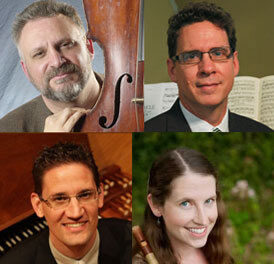A recording of the ambient piano piece, In a Landscape (1948) was playing while we waited in the lobby. And we were greeted by a photograph of the smiling face of Cage projected on a screen. The stage consisted of two grand pianos facing stage right and stage left. A laptop and public address system were placed on a table. Dr. Thomas Koch welcomed the audience. We had gathered in Titmus Theatre on the campus of NC State University, an intimate setting for A Centennial Retrospective on the Piano Music of John Cage (1912-1992).
Any serious student in the arts who has graduated since the 1980s has formed an opinion about John Cage. Considered one of the most influential composers of the twentieth century, Cage was often misunderstood at best, reviled by some, but greatly admired by others. Certainly his vast number of compositions, poems, lectures and visual art speaks volumes about his industry and dedication. According to Dr. Koch, Cage was often seen tossing coins or dice on the subway — a tedious and time-consuming practice that “removed his ego” from the process of composition. Koch continued to lecture between pieces, a practice that Cage would have likely affirmed. In addition to piano (prepared and not prepared) works, Koch was joined by Dr. Randolph Foy (Director of Orchestral Activities), Dr. Nathan Leaf (Director of Choral Activities), Megan Marvel (dancer, choreographer) and Daniel Salo (engineering student with piano performance minor).
Dr. Koch began the program with the first movement of Cage’s early ‘Weberian’ sounding 12-tone piece, Metamorphosis. Here we catch a glimpse of his teacher, Arnold Schoenberg, whose influence was short-lived. A more lasting impression, quite serendipitously, was via music student, Gita Sarabhai, who introduced Cage to the eastern philosophy. And it was beginning with the 1940s that Cage’s serious interest in process took hold.
Having already stumbled upon a method for altering the sound of the piano (Bacchanale, 1938) Cage put to work his newfound interest to create a collection of prepared piano pieces entitled Sonatas and Interludes (completed 1948). Virgil Thomson referred to the sound as reminiscent of the Balinese gamelan orchestra; they are short, but wonderful. Koch performed Nos. 1-4. Works for the unprepared piano were no less interesting.
Professor Nathan Leaf and Koch performed “The Wonderful Widow of Eighteen Springs” (1942), a charming duet with text adopted from Joyce’s Finnegan’s Wake. The vocal line consists mainly of a repeated descending step and closes with a lovely little glissando. Interestingly, the piano scoring resembles string tablature and Koch’s gentle tapping on the wood served as an effective contrast to the dreamy quality of Leaf’s perfectly balanced voice. “Jazz Study” (1942) was appropriately played by Daniel Salo, student of Professor Olga Kleiankina. Until recently, scholars were not unanimous in their opinion whether or not Cage actually penned the work. But the “ayes have it” and Salo’s excellent performance convinced me.
Ever looking for new ideas, Cage combined imagination with opportunity (or necessity). While in residence at the Cornish School in Seattle, Cage created percussion pieces for dance — some for prepared piano. When he left the Northeast for New York City, he continued to write for Merce Cunningham’s dance troupe. “In the Name of the Holocaust” (1942) was realized by the local choreographer and dancer, Megan Marvel. Her dance was strong, evocative and beautifully performed. Like Cunningham, Cage’s lifelong partner and source of artistic inspiration, Marvel created moves that were each unique — each searing itself into my memory. And like Cunningham’s dance, no two performances would be the same.
Dr. Randolph Foy joined Koch for “Music for Amplified Toy Pianos.” Managing a straight face while performing is required — but not for the audience. One could hardly observe their work without a chuckle. Author of Musicage (Wesleyan University Press) Joan Retallack describes Cage’s sense of humor — “his laughter, his mirthfulness . . . as central to his work.” Wes Parker and Koch performed one of Cages “number” pieces, “Two5.” Koch explained that the two players agreed upon only one aspect of the music — “what time it is.”
Whenever I hear a live performance of Cage’s work, I somehow feel his presence. Perhaps this evening he was here — when the house lights dimmed or the seat that insisted on squeaking during the third movement of “4’33.” When my partner and I made our way through the windy night, we were convinced.
This performance was one of “Random Acts of Cage,” a three-part series presented in partnership with the Raleigh Civic Symphony Association. Parts 2 and 3 will be presented on April 1 and April 22 both at 4 p.m. Videographer for Part 1 was Randall Rehfuss. The Knabe piano was provided by Richard Ruggero.












